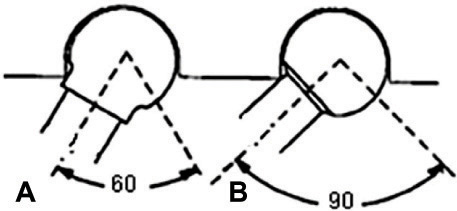J Korean Hip Soc.
2011 Jun;23(2):89-94. 10.5371/jkhs.2011.23.2.89.
Dislocation as a Complication after Total Hip Arthroplasty
- Affiliations
-
- 1The Joint Replacement, Center Ewha Womans University School of Medicine, Seoul, Korea. kjsos@ewha.ac.kr
- KMID: 2190718
- DOI: http://doi.org/10.5371/jkhs.2011.23.2.89
Abstract
- The prevalence of reoperation due to dislocation after total hip arthroplasty ranks high because of aseptic loosening, periprosthetic fracture and infection. Dislocation occurs in 0.5% to 4% of the cases in a year after primary total hip arthroplasty. The risk of dislocation is influenced by the position of the components, the surgical approach, the surgical techniques, the design of the prosthesis, the underlying diagnosis and the patient's compliance with restrictions. A better understanding of the etiology of dislocation and refinements of surgical techniques have led to a decrease in the rate of dislocation over time. Although most dislocations after total hip arthroplasty are a single episode that can be managed nonoperatively, some patients require surgical intervention to treat recurrent dislocation. The choice of surgical technique to manage recurrent dislocation depends on the etiology of the problem. The surgical options available for the treatment of recurrent dislocation consist of component revision, modular component exchange, use of a larger femoral head, soft tissue reinforcement, advancement of the greater trochanter, bipolar arthroplasty and use of a constrained liner.
Keyword
MeSH Terms
Figure
Reference
-
1. Berry DJ. Unstable total hip arthroplasty: detailed overview. Instr Course Lect. 2001. 50:265–274.2. Kim YH. The results of a proximally-coated cementless femoral component in total hip replacement: a five- to 12-year follow-up. J Bone Joint Surg Br. 2008. 90:299–305.3. Meek RM, Allan DB, McPhillips G, Kerr L, Howie CR. Late dislocation after total hip arthroplasty. Clin Med Res. 2008. 6:17–23.
Article4. Katz JN, Losina E, Barrett J, et al. Association between hospital and surgeon procedure volume and outcomes of total hip replacement in the United States medicare population. J Bone Joint Surg Am. 2001. 83-A:1622–1629.
Article5. Jolles BM, Zangger P, Leyvraz PF. Factors predisposing to dislocation after primary total hip arthroplasty: a multivariate analysis. J Arthroplasty. 2002. 17:282–288.
Article6. Woo RY, Morrey BF. Dislocations after total hip arthroplasty. J Bone Joint Surg Am. 1982. 64:1295–1306.
Article7. Woolson ST, Rahimtoola ZO. Risk factors for dislocation during the first 3 months after primary total hip replacement. J Arthroplasty. 1999. 14:662–668.
Article8. Alberton GM, High WA, Morrey BF. Dislocation after revision total hip arthroplasty : an analysis of risk factors and treatment options. J Bone Joint Surg Am. 2002. 84-A:1788–1792.9. Fackler CD, Poss R. Dislocation in total hip arthroplasties. Clin Orthop Relat Res. 1980. 151:169–178.
Article10. Lewinnek GE, Lewis JL, Tarr R, Compere CL, Zimmerman JR. Dislocations after total hip-replacement arthroplasties. J Bone Joint Surg Am. 1978. 60:217–220.
Article11. Suh KT, Park BG, Choi YJ. A posterior approach to primary total hip arthroplasty with soft tissue repair. Clin Orthop Relat Res. 2004. 418:162–167.
Article12. Kwon MS, Kuskowski M, Mulhall KJ, Macaulay W, Brown TE, Saleh KJ. Does surgical approach affect total hip arthroplasty dislocation rates? Clin Orthop Relat Res. 2006. 447:34–38.
Article13. Berry DJ, von Knoch M, Schleck CD, Harmsen WS. Effect of femoral head diameter and operative approach on risk of dislocation after primary total hip arthroplasty. J Bone Joint Surg Am. 2005. 87:2456–2463.
Article14. Beaulé PE, Schmalzried TP, Udomkiat P, Amstutz HC. Jumbo femoral head for the treatment of recurrent dislocation following total hip replacement. J Bone Joint Surg Am. 2002. 84-A:256–263.
Article15. Naito M, Ogata K, Asayama I. Intraoperative limb length measurement in total hip arthroplasty. Int Orthop. 1999. 23:31–33.
Article16. Cuckler JM. Limb length and stability in total hip replacement. Orthopedics. 2005. 28:951–953.
Article17. von Knoch M, Berry DJ, Harmsen WS, Morrey BF. Late dislocation after total hip arthroplasty. J Bone Joint Surg Am. 2002. 84-A:1949–1953.
Article18. Dewal H, Maurer SL, Tsai P, Su E, Hiebert R, Di Cesare PE. Efficacy of abduction bracing in the management of total hip arthroplasty dislocation. J Arthroplasty. 2004. 19:733–738.
Article19. Bourne RB, Mehin R. The dislocating hip: what to do, what to do. J Arthroplasty. 2004. 19:4 Suppl 1. 111–114.20. Daly PJ, Morrey BF. Operative correction of an unstable total hip arthroplasty. J Bone Joint Surg Am. 1992. 74:1334–1343.
Article21. Fraser GA, Wroblewski BM. Revision of the Charnley low-friction arthroplasty for recurrent or irreducible dislocation. J Bone Joint Surg Br. 1981. 63B:552–555.
Article22. Kaplan SJ, Thomas WH, Poss R. Trochanteric advancement for recurrent dislocation after total hip arthroplasty. J Arthroplasty. 1987. 2:119–124.
Article23. Parvizi J, Morrey BF. Bipolar hip arthroplasty as a salvage treatment for instability of the hip. J Bone Joint Surg Am. 2000. 82-A:1132–1139.
Article24. Callaghan JJ, O'Rourke MR, Goetz DD, Lewallen DG, Johnston RC, Capello WN. Use of a constrained tripolar acetabular liner to treat intraoperative instability and postoperative dislocation after total hip arthroplasty: a review of our experience. Clin Orthop Relat Res. 2004. 429:117–123.
Article
- Full Text Links
- Actions
-
Cited
- CITED
-
- Close
- Share
- Similar articles
-
- Modified Posterior Approach to Total Hip Arthroplasty
- The Causes and Treatment of Dislocations after Total Hip Arthroplasty
- Posterior Approach to Total Hip Joint Replacement Arthroplasty
- Dislocation After Total Hip Arthroplasty
- Iatrogenic Proximal Tibiofibular Fracture during Manual Reduction of Posterior Hip Dislocation After Total Hip Arthroplasty





